| © Copyright Robert Cole 2015
- No copying or distributing YAMASHIRO |

|
 |
| YAMASHIRO
RAI School - MAGOTARO KUNITOSHI
A controversy of study begs this head-master to
share his post. There are two opinions advanced in
reference.
Examination of the available material shows two
distinct style patterns in SUGATA, YAKIBA, BOSHI,
KAERI, NAKAGO and MEI. There are no overt
similarities. While one work states Two-characters
was the elder brother who died and others, the
father, MAGOTARO KUNITOSHI "Best Grandson" banners
the new head of an inherited RAI forge. MAGOTARO,
third from RAI TARO, created a new "FUNBARI" over
the exhausted KEN-CHO, full YAKIBA expansion to give
the country a clear, new path for the SUGATA styles
of late-KAMAKURA.
"Two-characters" NIJI KUNITOSHI KO-AN 1278 (f: KUNIYUKI, grf: KUNIYOSHI):
sword style. The constant outpour from OSAFUNE won a faddish
national acceptance of GUNOME by KO-AN 1278. NIJI
was head of the KYOTO RAI and his powerful pieces
contrast, utterly, the refined imposition of SANJI's
recall of graceful HEIAN FUNBARI. His new tapering
brought a new path for the country and an
established RAI style for SHO-O 1288. See The Ten Students |
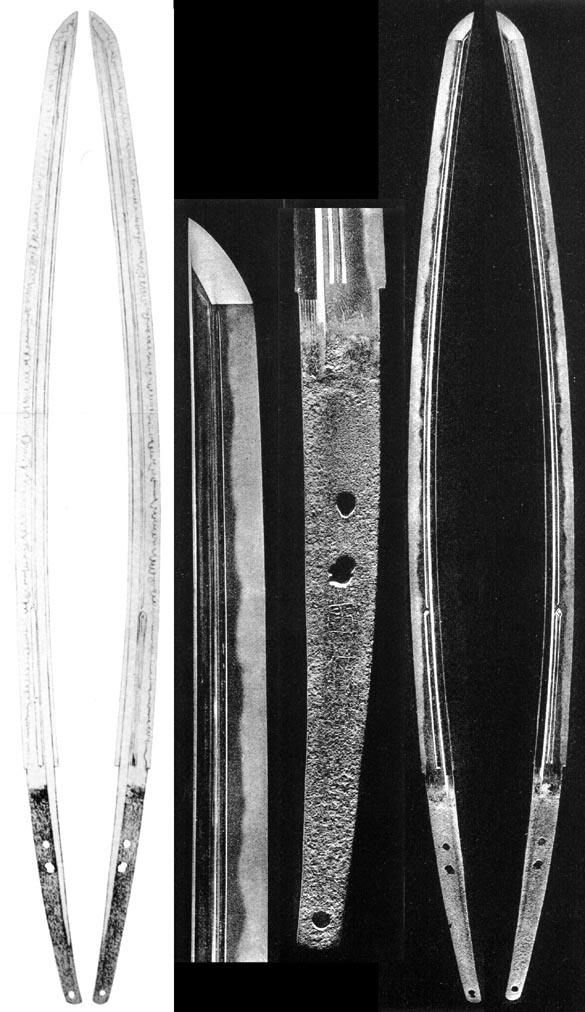
This sword is the
food-source for all KUNITOSHI descriptions.
|
Kunitoshi
- Kokuho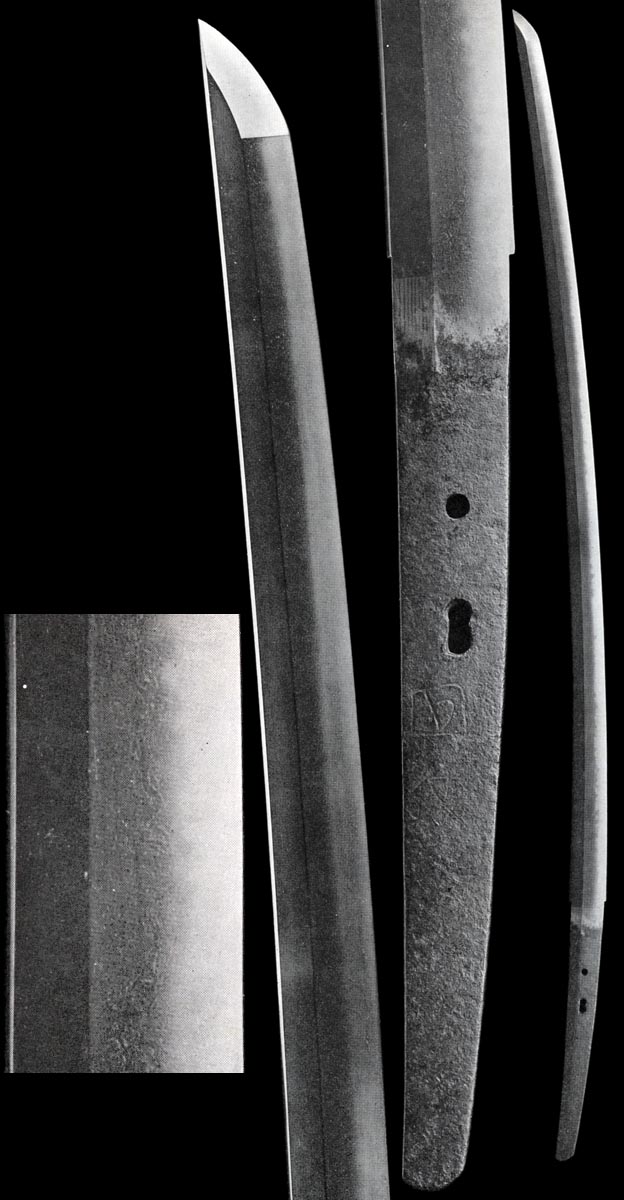 Kunitoshi - Kokuho Nagasa: 76.1cm Moto-Haba: 3cm Shinogi-Tsukuri, Ihori-Mune, little curve. Itame Hada has Ji-Nie profuse Chikei. Wide Yakiba of Nioi-Fukashi Choji-Midare with Ashi and Yo. The lower of profuse Nie Deki. Gunome-Choji Boshi with Kaen turn. Ubu Haagari Kurijiri has three Mekugi-ana, two of which have become joined. Signed in the mid. Kunitoshi |
Kunitoshi
- Kokuho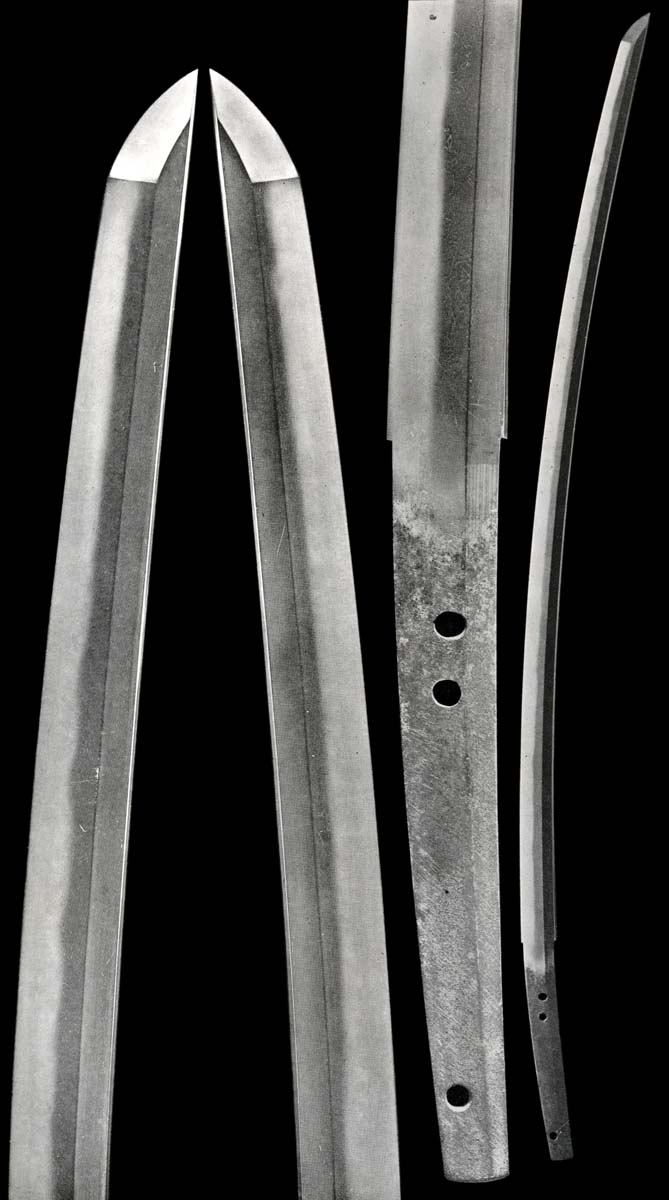 Kunitoshi - Kokuho Nagasa: 75.3cm Moto-Haba: 2.8cm Shinogi-Tsukuri, Ihori-Mune, deeply curved with Chu-Kissaki. Itame Hada has Ji-Nie and Chikei. Hiro-Sugu Nie-Deki and Nioi-Fukashi Ko-Choji-Midare with Sunagashi, Ashi and Yo. Figures widen to the Shinogi through the mid. Gunome-Choji Boshi with Hakikake. O-Suriage nakago has slight Kurijiri and three Mekugi-ana. Kunitoshi |
NAGASA: 28.8cm SORI: 0.2cm NAKAGO: 11.5cm HIRA-TSUKURI,IHORI-MUNE, wide-bodied TANTO. SU-KEN on OMOTE, BO-HI/SUE-BI extends on the URA. KO-ITAME HADA is veiled in JI-NIE and RAI NIE-UTSURI. A bright NIOI-GUCHI has KO-NIE where ASAKI-NOTARE undulates high-reaching GUNOME with TOGARI. KO-ASHI IRI defines. MIDARE-KOMI BOSHI has TOGARI in the head. Two MEKUGI-ANA on HA-AGARI
NAKAGO. Signed large, NIJI MEI: |
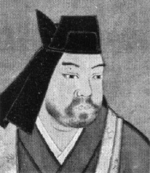 Uesugi Kenshin |
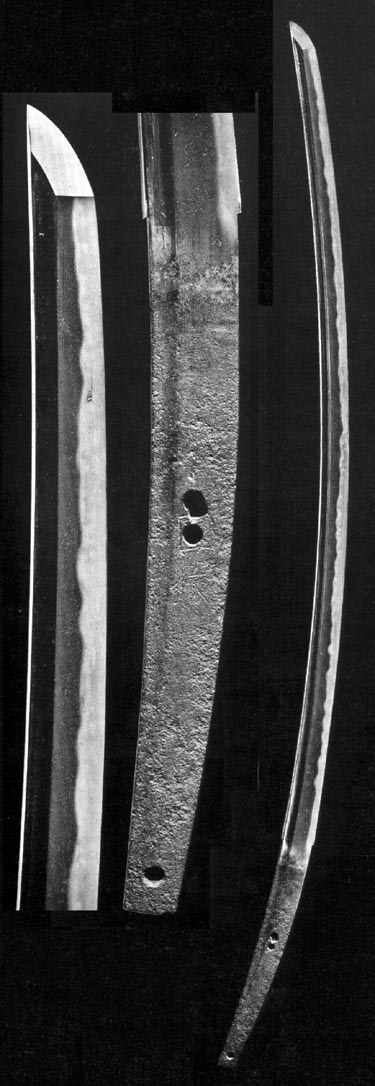 |
| NAGASA: 83.6cm
RAI NIJI KUNITOSHI, a true Samurai sword.
Powerful. A blend of the old KENUKI with the power
of mid-KAMAKURA.
UESUGI KENSHIN KYO-ROKU 3, 1530 to TEN-SHO 6, 1578. Vassals of the UESUGI, he was born NAGAO SARUMATSU-MARO, "The Pine Monkey," he became KAGETORA. His useless elder brother inherited and KAGETORA, 11, gave up and become a priest: SHUSHIMBO, traveling throughout the country. At HIEI-ZAN he met UESUGI clansman, USAMI SADAYUKI, who had fought his father until a peace in 1538. SADAYUKI convinced KAGETORA to return. At 13, with the help of SADAYUKI, he returned to ECHIGO, deposed his brother and first gained attention by placing control over brother-in-law, NAGAO MASAKAGE. When KAGETORA was 21, UESUGI NORIMASA sought
refuge from another beating by HOJO UJIYASU, one of
the ODAWARA father/son team engaged in the
KANTO. One year later, he shaved his head and became KENSHIN. Another year, 1553, he accepted an alliance with MURAKAMI YOSHIKIYO to protect their common real-estate from the TAKEDA. Thus brought history the most protracted series of Samurai battles - at KAWANAKAJIMA... |
| SHINGEN deflects KENSHINs' stroke |
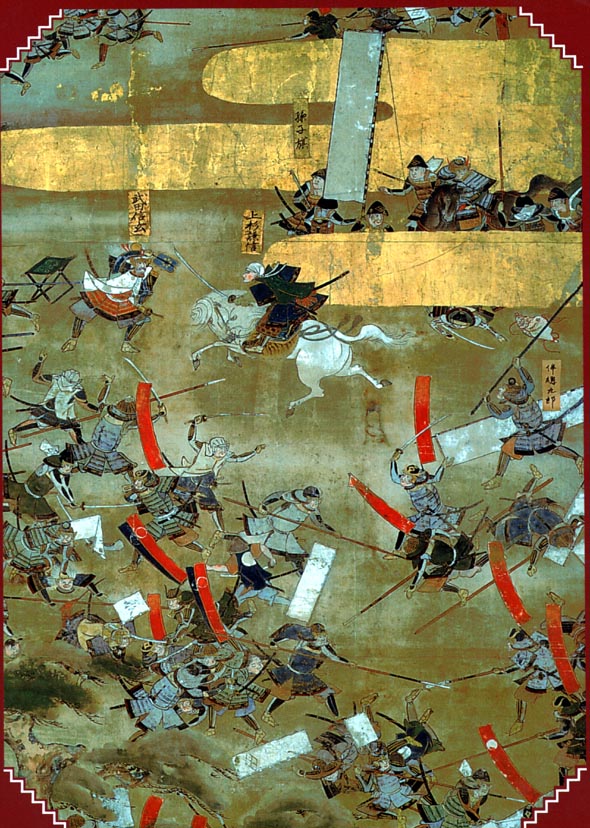 |
| They clashed on this ground
for 10 years. They knew each rock and brook.
They knew the mind and whispers of the fogs and mist,
and the birds of the field - for each helped or
hindered. Friend or foe.
Their four major encounters were every year skipping only the summer of 1555. TAKEDA SHINGEN's run for KYOTO was annually checked every summer by UESUGI KENSHIN. KENSHIN was checked by the ASHIKAGA SHOGUN's order to repress the HOJO. Everybody all taken up. The TAKEDA had ODA and IYEYASU in the winter and KENSHIN in the summer (See SHINGEN), KENSHIN had the HOJO at ODAWARA. Declaring on the HOJO, SHOGUN YOSHITERU gave, from his own name, "TERU" to join with KAGETORA's, "TORA" then becoming UESUGI TERUTORA "The Shining Tiger" of ECHIGO. He now fought SHINGEN and the HOJO. Eventually, the SHOGUN settled by having KENSHIN adopt HOJO UJIYASU's seventh, who took KENSHIN's "KAGETORA." This peace allowed full attention to SHINGEN, which left open his flank for a ripe try by ODA NOBUNAGA. While re-orienting, KENSHIN fell sick and died at 48. |
|